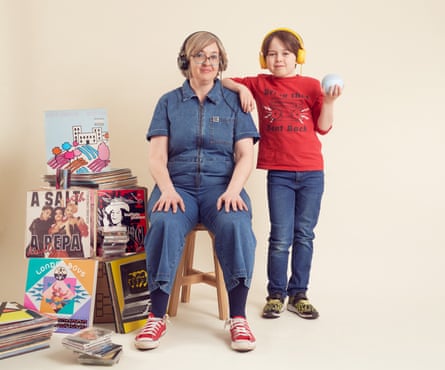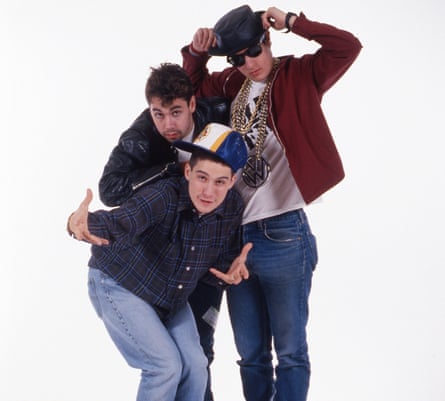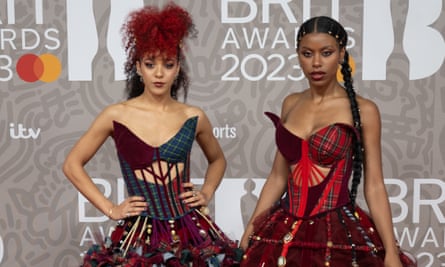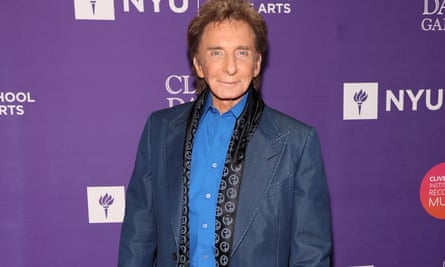The second we get in the car, my son strikes up his familiar tune. “I want my playlist, Mum!” Put your belt on, young man. “Pleeease?” Some politeness for a change. Belt. Now.
I get a second’s sweet peace as I hear the clunk-click. Then the noise: “Mum! I need my playlist right now!”
And so it begins. The playlist of my nearly-nine-year-old’s favourite pop songs, usually on shuffle, starts to shake through the car. I give in to his nagging often, but I know why I do. I remember the joy of becoming a music fan, discovering new sounds, worlds and ideas through verses and choruses, through the giddy rushes of rhythms and melodies.
I also know that my experiences were very different to his. At his age, I had to hang around the radio for hours or wait until Top of the Pops every Thursday, hoping that a song I loved would appear. These days, my son just asks Alexa.
By my early teens, if I wanted to own an album, the process was a little more convoluted: save £9.99 of pocket money, beg my mum to drive me to Woolworths five miles away, pray that they had it, and if they did, play it until its tape was run ragged or the vinyl was jumping with scratches. Now kids find any album online, in seconds, for free – or find a million tasters on TikTok in a fraction of the time. I worry that music is no longer rare and precious, but something we take for granted.

I hear my son rabbiting to his Echo Dot, bought by his grandmother for Christmas, in his bedroom. He skips quickly through songs and deletes them from his playlist without thought, as he might when music is so freely available and accessible. He’s started listening to a relaxing playlist to go to sleep and I worry about how moods are being targeted in music by a company’s algorithms. But I know he loves this music, albeit in a very different way to me. I wonder why I spend so much time worrying whether his experiences are as profound as mine and why it feels like it matters?
I know why it matters. I was five when my father died, suddenly and unexpectedly, in January 1984. My new book begins with the last moment that I saw him. I was at our front door saying goodbye, being reminded by Dad that he had set me a task: I had to find out what No 1 was in the Top 40 charts.
This would be revealed to the world while Dad was in hospital waiting for a hip operation to ease his ankylosing spondylitis. I never got to tell him the answer as he died two days later from a complication in the early stages of the operation. He was only 33. Pipes of Peace by Paul McCartney made it to the top, a song that still sings loudly and beautifully to me today.
After Dad’s death, my life felt guided, shaped and supported by songs and the people that sang them. I became fixated with flamboyant father figures like George Michael and Adam Ant, wrapping myself up in lyrics that told me “Girl, all I want right now is you” (Wham!’s Freedom), or “Ridicule is nothing to be scared of” (Adam and the Ants’ Prince Charming). In early adolescence, I fell in love with positive pop stars like Kylie Minogue and alternative maternal role models like Neneh Cherry, rapping Buffalo Stance while seven months pregnant on Top of the Pops. In my teenage years, groups like REM, Joy Division and Hole gave me gateways to other cultures, communities and attitudes far outside my native Swansea, and other people with whom I could bond.

I’ve always been fascinated by how music affects us and I delved into neuroscience in my book to discover how our brains and bodies are hardwired to respond so powerfully. According to a 2013 University of Helsinki study, humans are capable of memory-building from the womb (a group of babies were tested just before birth, then at four months, to see if they recognised a specific version of Twinkle Twinkle Little Star played to them in utero – and they did). Music can help give us security in our changing identity when we are hormonal adolescents, our bodies telling us to define ourselves separately from our family to help us mate beyond our genes. Wonderfully, I discovered through research that favourite songs can give us the same dopamine rush as an orgasm.
Music also helps us when we hurt and when we grieve, giving us a familiar place to help us explore and express our feelings – and our brains still respond to music right through to later life, including in people experiencing dementia. I’ve realised I want music to support my son in his life as well as it has supported me, and this feeling is intensifying as he gets older. He was only seven when I wrote my book, getting into his first pop songs that weren’t just for children. We have now travelled from his first love, the Spice Girls, a band he loved dancing to with his female cousins, to a playlist that he shuffles through skittishly. It’s more than 150 tracks long.
My worries about my son’s engagement with music, I realise, are partly about it existing in a digital space, where he can get lost in mood music, or give up self-control. But a chat with Professor David Hesmondhalgh, Professor of Music, Media and Culture at the University of Leeds, gave me pause. He referred me to his 2021 journal article, Streaming’s Effects on Music Culture, which underlined how music has always been tied to functions, from social rituals like weddings and funerals to intimate rituals like singing babies lullabies to send them to sleep. “The recent concerns about the use of music to accompany other activities can seem rather odd when seen in this historical context,” he added.
Hesmondhalgh’s article also cited a sample of 5,000 streaming-service users by Norwegian researcher Anja Nylund Hagen in 2015, which involved people keeping strict music diaries, showing many of them “exercising skill and creativity in searching and browsing, and engaging in substantial curation”. Another study by Dutch marketing professor Hannes Datta showed that new users of a streaming service significantly increased their consumption of artists, tracks and genres that they had not previously encountered.
My son’s playlist is a mishmash of genres that also collapses the distance between decades. Alongside contemporary tracks by Nova Twins, George Ezra and Olivia Rodrigo are Roxette by Dr Feelgood, Copacabana by Barry Manilow and Song For My Father by Horace Andy. He also changes his top 10 all the time: his current favourite is Bonkers by Dizzee Rascal which, unbelievably, is now 14 years old.
The closest I got to this was making mixtapes in my mid-teens: a laborious process involving a double tape deck and much more planning involving controlling the order of songs. When I was in my mid-20s, my mother found a box of cassettes that included a similar tape made by my father. The clunk of record and play buttons being pressed together between songs by Kim Wilde and Roxy Music still hit my heart like a hammer.

My “reminiscence bumps” – otherwise known as the vivid recollections of favourite music for people over 40 – are something neuropsychologist Professor Catherine Loveday, of the University of Westminster, is an expert on. So does waiting for music or saving up for it increase the intensity of connection to songs? “Hearing people say, ‘This was the first record I bought’ or ‘I saved for ages to get this’ is common in my work, yes – but it’s important to remember I have interviewed people from their 40s to their 80s,” she says. The older people’s experiences of accessing music were very different, but the way their reminiscence bumps work was very similar.
When Loveday’s older interviewees were teenagers, pop music was not on mainstream radio or TV and music was much harder to buy. Even though young people’s access is almost immediate if they have the right technology, Loveday thinks younger people will experience similar reminiscence bumps when they’re old enough to be studied – and may have an even deeper connection to songs.
“We’re not going to know the answer to how they remember music,” she says, “until we are 20 years down the line, but we can already see that younger people seem to recognise music that comes from their grandparents’ and parents’ generations much more strongly. And given that you can listen to music more, I wonder if our musical memories will just become even more robust and feel even more powerfully attached to our sense of who we are.”
A regular collaborator of Loveday’s, Professor Alex Lamont of Keele University, also points out that our adult behaviours still get repeated by our children, albeit on different platforms. “I know that streaming allows new kinds of exploration and listening to algorithm-driven playlists, but nothing is stopping a person from repeating a track either. Look at Spotify play counts and some of those songs are definitely getting played again and again.” I think about how often I’ve heard Bon Jovi’s Livin’ on a Prayer or Black Eyed Peas’ Where is the Love? in recent weeks and I realise I am ignoring what’s in front of me – my old behaviours coming through in a new generation.

I also realise that when I was growing up, I was allowing music to be another parent. Then I look at my playlist and see songs by Self Esteem, Yazz and Frankie Valli, songs that my son first heard because of me, Dexys Midnight Runners and Stevie Wonder that were first played by his dad, and others from his uncles, aunties and grandparents. Music is already providing him with family.
As Dr Liz Giuffre, the co-author of the new book, Popular Music and Parenting, explains, we don’t listen to things ever entirely on our own. “We’re always thinking about who these songs connect us to – to the artists themselves, to friends or family, or to other people we don’t know yet in the world who might really understand us.” The beautiful thing about popular music, she adds, “is that it is so accessible and not elitist – it’s everyday, so we can all experience it now. It can help us forge so many new social connections today, and later on, in later life.”
Giuffre also thinks that worries about music today ignore every development in the transmission of music in the past. “I mean, when recorded music first came out, people were like, nobody’s ever going to learn how to play anything ever again. Then came radio and nobody’s ever gonna go and see live music, because you never have to leave your house to hear it.” Then came TV, online culture, social media platforms… adults are merely being nostalgic, Giuffre says, “for ‘how good we had it’ when we were young. And it’s the job of kids to say, ‘I don’t care how good you had it, I will find another way.’ Because it’s their job to.”
I know she’s right. I know this when I hear the Weeknd, REM and Boney M singing loudly from the Echo Dot upstairs, hearing my son’s feet dancing through the ceiling. I know it when I catch my son’s face in the rearview mirror, singing along to Beastie Boys and the Weather Girls in the backseat. He does “need his playlist” as I did – and as I still do, as my experiences of songs old and new help to form new layers of memories that will last me all my life. They are also joining me and my father and my son, as the music plays on.
The Sound of Being Human: How Music Shapes Our Lives by Jude Rogers is published by White Rabbit at £9.99. Buy it for £9.29 at guardianbookshop.com
